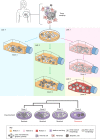The secret lives of cancer cell lines
- PMID: 30459183
- PMCID: PMC6262811
- DOI: 10.1242/dmm.037366
The secret lives of cancer cell lines
Abstract
The extent of genetic and epigenetic diversity between and within patient tumors is being mapped in ever more detail. It is clear that cancer is an evolutionary process in which tumor cell intrinsic and extrinsic forces shape clonal selection. The pre-clinical oncology pipeline uses model systems of human cancer - including mouse models, cell lines, patient-derived organoids and patient-derived xenografts - to study tumor biology and assess the efficacy of putative therapeutic agents. Model systems cannot completely replicate the environment of human tumors and, even within the same cancer model, data are often irreproducible between laboratories. One hypothesis is that ongoing evolutionary processes remain relevant in laboratory models, leading to divergence over time. In a recent edition of Nature, Ben-David and colleagues showed that different stocks of widely used cancer cell lines - a staple of cancer research over many decades - are highly heterogeneous in terms of their genetics, transcriptomics and responses to therapies. The authors find compelling evidence of positive selection based on ongoing mutational processes and chromosomal instability. Thus, the origin, culture conditions and cumulative number of population doublings of cell lines likely influence experimental outcomes. Here, we summarize the key findings of this important study and discuss the practical implications of this work for researchers using cell lines in the laboratory.
Keywords: Cancer; Cell line; Genetic heterogeneity; Tissue culture; Tumor cell line.
© 2018. Published by The Company of Biologists Ltd.
Conflict of interest statement
Competing interestsThe authors declare no competing or financial interests.
Figures

Comment on
-
Genetic and transcriptional evolution alters cancer cell line drug response.Nature. 2018 Aug;560(7718):325-330. doi: 10.1038/s41586-018-0409-3. Epub 2018 Aug 8. Nature. 2018. PMID: 30089904 Free PMC article.
References
-
- Berenjeno I. M., Piñeiro R., Castillo S. D., Pearce W., McGranahan N., Dewhurst S. M., Meniel V., Birkbak N. J., Lau E., Sansregret L. et al. (2017). Oncogenic PIK3CA induces centrosome amplification and tolerance to genome doubling. Nat. Commun. 8, 1773 10.1038/s41467-017-02002-4 - DOI - PMC - PubMed
Publication types
MeSH terms
Grants and funding
LinkOut - more resources
Full Text Sources

